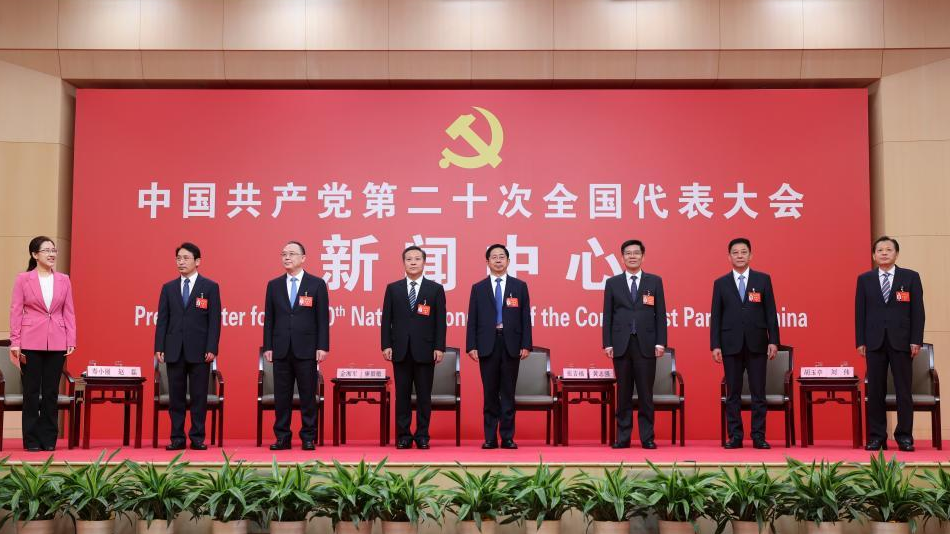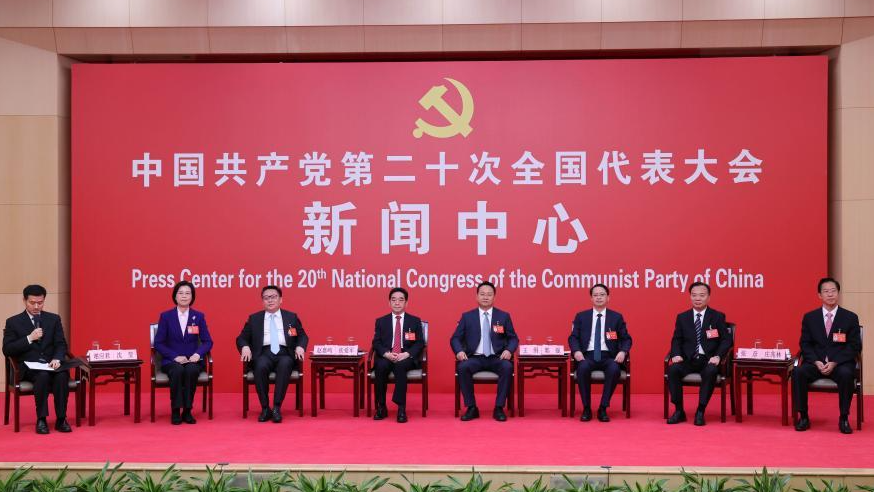
Spokespersons for the delegations (second from L-R) from Beijing, Tianjin, Hebei, Shanxi, Inner Mongolia, Liaoning and Jilin attend the first group interview in Beijing, capital of China, October 18, 2022. /Xinhua
Spokespersons for the delegations (second from L-R) from Beijing, Tianjin, Hebei, Shanxi, Inner Mongolia, Liaoning and Jilin attend the first group interview in Beijing, capital of China, October 18, 2022. /Xinhua
Delegates from multiple provinces and municipalities across China on Tuesday shared their insights on industrial growth, collaborative development, food security and other important areas during the first and second group interviews hosted by the Press Center for the 20th National Congress of the Communist Party of China (CPC).
Industrial chains
Delegates from the Yangtze River Delta – comprising Shanghai Municipality and parts of Zhejiang, Jiangsu and Anhui provinces – said work on the region's integration has picked up pace alongside the national pursuit of high-quality development. Upgrading industrial chains and enhancing their synergy lies at the core of the region's development strategies, they added.
Zhao Jiaming, spokesperson for the delegation from Shanghai, said the municipality in East China has been making new breakthroughs in critical and core technologies and further modernizing the industrial chains to build an influential world-class industrial cluster in the Yangtze River Delta together with the other three provinces.
Based on the characteristics of industrial development in the Yangtze River Delta, the four provincial-level regions have formed four alliances for the development of industrial chains in integrated circuits, biomedicine, artificial intelligence and new energy vehicles, Zhao said.
Guo Qiang, spokesperson for the delegation from Anhui Province, said the province achieved leapfrog development over the past 10 years, transforming from a traditional agrarian province to a place where emerging industries converge.
"Over the years, we have been focusing on boosting the real economy with the growth of the manufacturing industry," said Zhang Aijun, spokesperson for the delegation from Jiangsu Province. In 2021, Jiangsu recorded a GDP of 11.64 trillion yuan, of which the manufacturing industry accounted for 4.2 trillion yuan, or 36 percent, which is a relatively high proportion in the country, he said.
More than 50,000 large manufacturing enterprises in the province have undergone digital transformation, Zhang said, adding that the value of Jiangsu's digital economy exceeded 5 trillion yuan, ranking among the top in the country, as of the end of last year. Enjoying relatively complete industrial categories and chains, the manufacturing industry's development in Jiangsu has laid a solid foundation for the province's high-quality development, he said.

Spokespersons for the delegations (second from L-R) from Heilongjiang, Shanghai, Jiangsu, Zhejiang, Anhui, Fujian and Jiangxi attend the second group interview in Beijing, capital of China, October 18, 2022. /Xinhua
Spokespersons for the delegations (second from L-R) from Heilongjiang, Shanghai, Jiangsu, Zhejiang, Anhui, Fujian and Jiangxi attend the second group interview in Beijing, capital of China, October 18, 2022. /Xinhua
Collaborative development
The delegates also talked about how different regions in China collaborate for high-quality development.
Beijing is working with neighboring regions to build a new city cluster for better urban development, ending the unlimited expansion of the Chinese capital, said Zhao Lei, spokesperson for the Beijing delegation. The goal is to team up with Hebei Province and Tianjin Municipality to build an eco-friendly chain of cities that cater to diverse needs.
"Beijing can focus on innovation while Tianjin helps with incubation and product trial that follows," said Tianjin's delegate Jin Xiangjun, taking innovation as an example. "In terms of expanding the scale of the industries, we can cooperate with Hebei Province," he said, explaining that Tianjin is cooperating with Hebei to build up a world-class cluster of ports.
Hebei Province has been accelerating its growth by accepting the transfer of industries from Beijing and Tianjin, said Lian Yimin, a delegate from the province, talking of shared achievements made in areas including transportation, environment and industry development.
"Over 40,000 firms from Beijing and Tianjin have moved to Hebei Province," Lian said. The province has also been building up its innovation capabilities – as many as 15,000 companies benefit from favorable policies on innovation while the number of small- and medium-sized tech firms has gone up by 29.7 percent, he added.
Shanghai, Zhejiang, Jiangsu and Anhui made joint efforts in infrastructure, technological innovation and ecological development besides jointly carrying out some key projects across the region, said Zhao, speaking on the collaborative work in the economic sector in the Yangtze River Delta.
According to the delegates, people in the Yangtze River Delta can use a single card to access over 1,000 services related to healthcare and tourism sectors. In addition, people can also use over 130 public services in different provinces as long as they all fall in the same region.
Food security
The report to the 20th CPC National Congress makes strategic arrangements for boosting the agriculture sector.
Shen Ying, spokesperson for the delegation from Heilongjiang Province, said the province has always regarded planting good grains as a top priority. The province ranks first in China in grain output, commerical sales and export volumes.
Heilongjiang enjoys advantages in agricultural modernization, with the contribution rate of agricultural science and technology progress reaching 69 percent, the agricultural mechanization rate reaching over 98 percent, and the high-standard farmland reaching 100 million mu (6.67 million hectares), according to Shen.
The province will continue to promote the development of large-scale, digital and modern agriculture, she said.